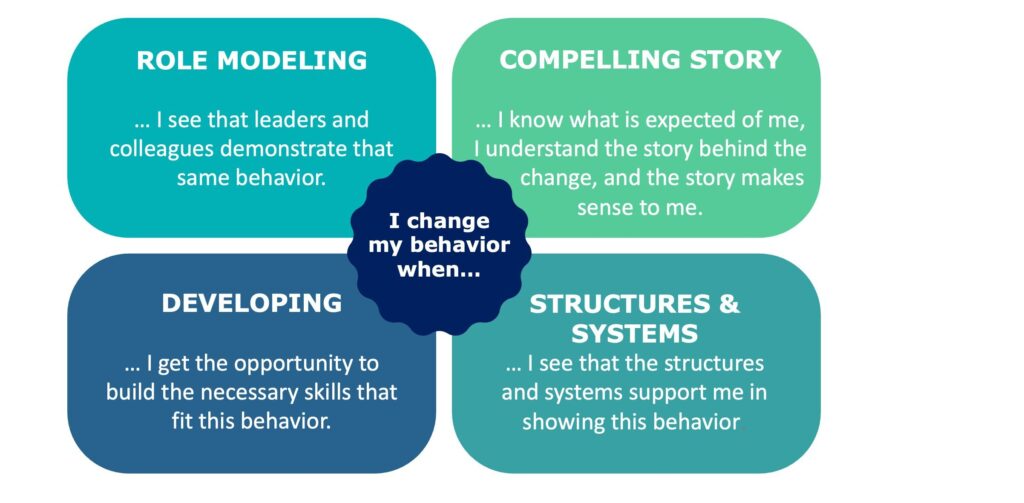Change takes more than a good story – four keys from McKinsey’s influence model

When I talk with executive teams about change, the conversation usually drifts toward structures, processes, and KPIs. Understandably so — those are the visible levers leaders can pull. But real change doesn’t start there. It happens when people shift their behavior, beliefs, and routines. That’s where communication makes the difference. Not as an afterthought, but as a strategic tool to create direction, meaning, dialogue, and movement.
One model that helps spark this conversation with managers is McKinsey’s Influence Model. It shows that change only sticks when four building blocks come together: conviction, reinforcing systems, skill development, and role modeling. It’s both practical and thought-provoking — a great way to explore with leaders where communication can and cannot make an impact.
In this blog, I’ll walk you through these four keys to change and show how communication strategy and leadership strengthen each other in the process.
Whether it’s implementing new processes, reshaping a company culture, or adopting innovations, change is a constant in organizations. Yet success rarely depends on plans or technology alone — it depends on the mindset and behavior of the people who make up the organization. In earlier blogs, I’ve explored De Caluwé and Vermaak’s change colors, Hilary Scarlett’s Building on Trust, and Kotter’s change approach. In this one, I’ll focus on McKinsey’s Influence Model — a framework where the change story plays a central role.
TL:DR in short
A strong change story is vital — but it’s not enough to truly change behavior. McKinsey’s Influence Model shows that lasting change depends on four keys: understanding and conviction, reinforcement through systems, skill development, and role modeling by leaders. Communication plays a strategic role in connecting these four: creating meaning, making behavior visible, and helping leaders turn words into action.
The Four Keys to Change
McKinsey’s model offers a clear, hands-on view of what drives behavioral change, centered around the question:
“I will change my behavior if…”
Let’s dive into the four building blocks.

Figuur 1: McKinsey’s influencemodel
1. Understanding and Conviction – The Power of a Change Storyhaal
When people truly understand why a change is happening, they are far more motivated to adjust their thinking and actions. Yet many change programs skip this step, assuming everyone already knows why things must change. The first key to effective transformation is therefore creating understanding and conviction. People need to grasp not only what is changing, but why. McKinsey highlights the power of a compelling change story — one that helps everyone see where the organization is headed, why the shift is needed, and how it benefits them. Such a story acts as a compass: it gives direction, builds connection, and increases motivation.
2. Reinforcing Change with Systems – Beyond Rewards
The second building block focuses on strengthening change through formal mechanisms. Traditional rewards and penalties are well-known tools, but McKinsey stresses there’s more to it than financial incentives. Yes, rewarding desired behavior helps — but it must go hand in hand with creating an environment that encourages collaboration, shared purpose, and intrinsic motivation. Financial rewards have their limits. Culture, purpose, and meaning often matter more. Organizations that align systems and culture with the new behavior are far more likely to make change stick.
3. Developing Skills and Awareness – Building Capability for Change
The third key centers on enabling people to change. Motivation alone isn’t enough — employees must have the right skills and awareness. McKinsey points out the importance of realistic self-assessment and external feedback to identify where development is needed. Training, coaching, and reflection programs give employees the tools and confidence to adopt new ways of thinking and acting. In other words: people can’t be the change if they aren’t equipped to live the change.
4. Role Modeling – Leadership that Sets the Tone
Finally, McKinsey underlines the power of example behavior. People are influenced more by what they see than by what they hear. Leaders and informal influencers shape norms through their actions every day.
For change to take hold, leaders must embody the behavior they expect from others. Culture isn’t written in slide decks — it’s demonstrated in everyday choices, tone, and attitude. Organizations should also recognize the importance of informal networks and culture bearers who often set the tone as much as executives do.
Making Change Work: Practical Insights from McKinsey
While the four keys provide a clear framework, implementation is often the hardest part. McKinsey offers several practical insights that make change efforts more successful:
Shared priorities: Create a collective understanding of what really matters and translate it into clear action plans. This is where internal communication plays a crucial role.
Active leadership involvement: Leaders must help design and champion the change, not just endorse it from the sidelines.
Storytelling as a connector: Using authentic stories builds understanding, emotion, and shared purpose. Storytelling workshops can help leaders make the change story everyone’s story.
Conclusion
McKinsey’s four keys to change highlight what truly drives transformation inside organizations. By fostering understanding and conviction, reinforcing the right systems, building skills, and setting the example, organizations dramatically increase their odds of success.
Communication ties these elements together — turning plans into meaning, behavior into culture, and leadership into lived example. That’s how change becomes not just a message, but a movement.
Huib Koeleman
Sources:
Jeff Boudens, Rodgers Palmer & Brooke Weddle: Mobilize Your Organization with a Powerful Change Story, 2019
The Four Building Blocks of Change, McKinsey Quarterly, 2016
De vier bouwstenen van verandering, Boom Management


